Tanzania
Tanzania, in long form the United Republic of Tanzania or United Republic of Tanzania is a country in East Africa located on the edge of the Indian Ocean, in the tropical part of the southern hemisphere. It is bordered to the north by Kenya and Uganda, to the west by Rwanda, Burundi and the Democratic Republic of the Congo, to the southwest by Zambia and Malawi and to the south by Mozambique. The country covers 945,087 km2 and had more than 51 million inhabitants in 2015, mainly Bantu. Its capital is Dodoma, located inland, but the main economic hub is the former capital Dar es Salaam, located on the coast. The official languages are Swahili and English, but Arabic is also spoken, notably on the islands of Zanzibar and Pemba. Present-day Tanzania was born from the union of Tanganyika and Zanzibar on April 26, 1964, shortly after their respective independence from the United Kingdom. It has been a member of the Commonwealth since late 1961 and of the United Nations since December 14, 1961.
Tanzania’s history
From 1964 to the present: independent Tanzania
The Nyerere regime: 1964-1985
Anxious to accelerate the emancipation of Africans from the Western world, inspired by communist experiences in China, Nyerere resolutely engages in a socialist policy. In February 1967, when Arusha was declared, he defined the principles and doctrines which he wished to see followed by the country. According to Nyerere’s ideal, African socialism must lead to the creation of an egalitarian, just and united society, which finds in its own resources the means of its self-sufficiency. Education is the number one priority. It must be said that there is an emergency in this area: Tanzania produced at that time only 120 graduates per year.
The first concrete measures to implement this policy are not long in coming. The main industries and service companies are nationalized, taxes increased for a greater distribution of wealth and racial discrimination abolished. The biggest changes are in agriculture, the country’s main economic sector. Called Ujamaas, that is to say cofraternities, village communities are organized on collectivist principles. Financial incentives encourage the formation of cooperatives. In October 1969, Bibi Titi Mohammed and ex-Minister Michael Kamaliza were arrested with four army officers. They are accused of having planned a coup. In Zanzibar, the Afro-Shirazi Party pursues an authoritarian policy, with an overtly revolutionary tendency. Arab and Indian properties are nationalized. Some disagreements even appear between Nyerere and Karume, the latter wanting to get closer to the communist world than the Tanzanian president who seeks, him, to spare the relations with the West as much as possible. In 1972, Karume was assassinated by opponents of the regime. A national funeral is returned to him, in the presence of Julius Nyerere.
In foreign policy, Tanzania gives support to the lumumbist guerrillas in the Congo and the OAU establishes its seat in Dar es Salaam and several revolutionary movements have a representation in the country (the ANC, ZANU, SWAPO, the MPLA and FRELIMO). At the same time, relations are deteriorating with Western countries; in 1965 Tanzania broke off relations with the United Kingdom and expelled British troops out of the country in reaction to London’s support for a segregationist regime in Rhodesia, while West Germany broke off its own relations with Tanzania following the opening of an East German embassy in the country. Economic aid granted by certain western countries is cut. On the other hand, the Portuguese colonial forces bombed the south of the country to cut the supply routes of the Mozambican FRELIMO, supported by the government of Julius Nyerere. During these years, Tanzania received aid from China, although it was itself developing. It is with Chinese support that the TAZARA railway line from Dar-es-Salaam to Zambia was built in 1975. It is also on the model of the Chinese communes that 800 collective villages are created, bringing together populations of ‘different ethnic and tribal origins, forcibly displaced by truck. It is estimated that in four years, from 1973 to 1976, 9 million people were displaced. This policy, if it allows a certain mixing between the different ethnic groups that make up the Tanzanian population, brutally breaks the human and community references of individuals.
These interventionist and utopian policies are bringing less and less the expected results. The first oil shock of 1973 greatly clouded the economic prospects of the country. Manufacturing and agricultural production are declining, planning of the economy by the administration is ineffective. Politically, the TANU parties of Nyerere and the ASP came together and merged in 1977 to form the Chama cha Mapinduzi (CCM), that is to say the Party of the Revolution. Despite the economic difficulties, the country is at peace and receives many refugees from neighboring countries at war or fleeing the Idi Amin Dada regime in Uganda. Nyerere refuses that the administration’s Africanization policy favors only Tanzanians and allows foreigners to access public jobs. Many also obtain Tanzanian citizenship, including white refugees. Tanzania’s relations with its African neighbors, particularly those in the north, Uganda and Kenya, have deteriorated over the years. The intentions were however good since these three countries formed in 1967 the East African Community (Community of East Africa) with the aim of eventually constituting a common economic market. The first cooperation aimed in particular at standardizing exchange and currency control policy. But Kenya, close to western countries, is moving further and further away from Tanzania supported by the Chinese Communists, and the border between these two countries was even closed from 1977 to 1983. In Uganda, the leader Idi Amin Dada, who has ambitions for territorial expansion, criticizes its Tanzanian neighbor for hosting opponents of his regime. Uganda attacked Tanzania in late 1978 and invaded the vicinity of Lake Victoria. The Tanzanians, with the help of Chinese military equipment, manage, after several months of effort and at the cost of heavy human losses, to recover the lost territories and even occupy Uganda for almost two years.
The war was expensive, about $ 500 million, and in the early 1980s, with no real industry, with an unproductive agricultural sector, Tanzania was one of the poorest countries on the planet. As the country sinks into failure, Nyerere begins to gradually modify its interventionist policy conducted since the mid-1960s. With the increasing intervention of the World Bank and the IMF, the financial incentives for collectivist production are partly redirected towards an investment for large state farms and for road infrastructure. In 1984, the possibility of private ownership of the means of production appeared and society was very gradually liberalized.
From 1985 to today
Tanzania’s politics
Tanzania is a multiparty federal republic with a presidential system, where the president is both head of state and head of government. Executive power is in the hands of the government while legislative power is shared between the government and parliament. The judiciary is independent from both the executive and the legislature. The main party is the Chama cha Mapinduzi (Party of the Revolution).
Tanzania has been officially independent since December 9, 1961. The following year, Julius Kambarage Nyerere, socialist leader of the African National Union of Tanganyika, was elected president. Nicknamed “Mwalimu”, a Swahili word meaning “teacher”, he intended to give priority to education and teaching. The country lived under a single-party socialist system until the mid-1980s. President Ali Hassan Mwinyi embarked on a series of economic and political reforms. The multiparty system was introduced at the beginning of 1992, which saw the registration of eleven new political parties. In 1994, Tanzania had its first multi-party elections, won by the Chama cha Mapinduzi (CCM). The October 2000 presidential election saw CCM candidate Benjamin Mkapa defeat his three main rivals with 71% of the vote. The CCM then obtained 202 of the 232 seats in parliament. Abeid Amani Karume, son of former President Abeid Karume, won the Zanzibar presidential election against Seif Sharif Hamad, candidate for the United Civic Front (FCU). The elections were marred by irregularities and the riots that followed left 23 dead, mostly on Pemba Island. Sixteen members of the FCU were expelled from parliament after boycotting the sessions in protest against the election results in Zanzibar.
In October 2001, the CCM and the FCU signed an agreement calling for further electoral reforms and establishing a commission of inquiry to shed light on the January 2001 deaths in Pemba. The agreement also mentioned the appointment by the president of a member of the FCU to parliament. The constitutional changes made in April 2002 enabled the CCM and the FCU to each appoint the members of the Zanzibar Election Commission. In May 2003, the latter organized complementary elections to allocate the seats that remained vacant following the boycott of the FCU. Observers called the elections the first major test of the free and fair reconciliation agreement between the two parties. In 2012 a commission to revise the constitution was formed to gather the opinion of society on an evolution. It delivered a first version to President Jakaya Kikwete on December 30, 2013. The referendum which was to take place in April 2015 has been postponed sine die by the National Election Commission (NEC) following the delay in setting up the biometrics in the establishment of electoral lists.
Tanzania’s economy
The economy of Tanzania is, in many ways, typical of a developing country. Mainly focused on agriculture and the mining industry, it has an almost nonexistent and uncompetitive industrial base. In 2009, agriculture thus represented more than 25% of GNP, more than 30% of exports and 70% of jobs. Tourism is an appreciable and growing source of foreign exchange there.
But the country is also very different from most African countries, with an Arab and Persian merchant presence on its coasts, trade dating from the first centuries of the common era, and a city, Zanzibar, which for several hundred years dominated the economy of the whole region. Hub of the gold, ivory and slave trade, at the interface of the African, Arab and Indian worlds, its hinterland extends to the Africa of the Great Lakes, at nearly 1,000 km away. The arrival of Europeans in the wake of Vasco da Gama in the fifteenth century does not immediately call this domination into question, they even offer new markets for a popular local commodity, cloves. The country was among the top eight cotton producers in East, South and North Africa in the mid-2010s. It was above all the fifth among African tea producers at the start of the decade 2010, dominated by Kenya.
The gradual establishment of the German and British colonial empires, however, relegated the region outside the main axes of development. Accession to independence in the early 1960s saw the young United Republic of Tanganyka and Zanzibar (its original name) turn to a “African socialism” of Maoist inspiration which quickly proved to be a failure : rather than taking off and modernizing, the country’s economy is collapsing. The ensuing questioning, from the mid-1980s, gradually led the country to return to the regional economic scene. The frank liberalization carried out in the first years of the 21st century, coupled with governance efforts, allowed the massive arrival of foreign investors in all sectors of the economy. For the first time in its young history, this chronically underdeveloped country seems to be receiving the first dividends from its efforts. The tourism potential of Tanzania, with its coastline composed of superb beaches on the Indian Ocean, the northern region which includes Kilimanjaro, the crater of Ngorongoro and the largest animal reserves in Africa, the presence of most of the large lakes of the continent and its political stability, is also very important and continues to develop.
Tanzania’s demography
Tanzania was populated with 44,929,002 inhabitants in December 2012. The literacy rate is 69.4% for people over 15 years of age. On the continent, 99% of the population is of African origin (including 95% of Bantu spread over more than 130 ethnic groups), the remaining 1% being represented by Asians (260,000), Europeans (20,000) and Arabs ( 70,000). In Zanzibar, the population is made up of a more heterogeneous mixture of Africans and Arabs. Tanzania hosts more than 500,000 refugees on its territory, mainly from Burundi and the Democratic Republic of the Congo.
Tanzania’s education
In colonial times
The arrival of education in Tanzania dates back to colonial times. Indeed, colonization led to the appearance of schooling in the country, on a Western model since Germany is said to be a colonizer. Its teaching policy is modeled on what is called assimilationism. Then comes the British model, when Germany no longer has Tanzania, which is based on differentialism. These ways of teaching have deeply marked the Tanzanian educational model. Shortly before Independence, the school system was characterized by a strong segregation of Europeans, Asians (Asians mainly from India) and Africans, to the detriment of the latter. Be that as it may, the two colonizing powers never considered education in Tanzania a major concern, an important point of their colonial policy. This left an important legacy for the future (during Independence), with an education system that was very weak and very fragile.
Tanzania’s language
There are over a hundred languages spoken in Tanzania, none of which exceeds 16% of the population. Swahili, although only the mother tongue of 1% of Tanzanians, is used as a working language for 95% of the country’s population, while English, the language of the former British colonizer, is no longer or less understood than by 5% of the inhabitants. English arrived late, especially after 1921, because before 1919, Tanganyka which corresponds to more than 96% of present-day Tanzania was German East Africa. Tanganyka will form Tanzania in 1962, from union with Zanzibar. The population, the vast majority of whom live on less than $ 2 a day, travels very little abroad, which favors Swahili, and results in a relative decline in English. In addition, the media in Swahili are numerous, and television broadcasts mainly in this language. Swahili is written in the Latin alphabet, which is also useful for learning English. Arabic, once an important language, especially in Zanzibar, has almost disappeared from Tanzania. German is taught at the university and at the Goethe Institute in Dar es Salaam.
-
Health

Tanzania Government Declares End To Deadly Marburg Virus Outbreak, Confirms WHO
Tanzania on Friday declared an end to the deadly Marburg virus outbreak, more than two months after it was first…
Read More » -
Tanzania
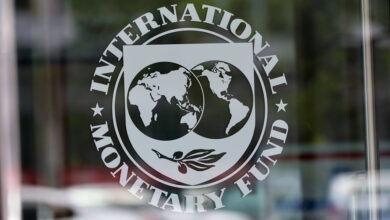
IMF Board Approves Immediate Disbursement Of About $153 Million To Tanzania
The International Monetary Fund (IMF) on Monday announced it has approved the first review of Tanzania’s three-year extended credit facility,…
Read More » -
Equatorial Guinea

US Health Agency Warns Travellers To Watch Out For Deadly Marburg Virus Symptoms
The United States (US) Centers for Disease Control and Prevention (CDC) on Sunday urged travelers traveling to Guinea and Tanzania…
Read More » -
Tanzania
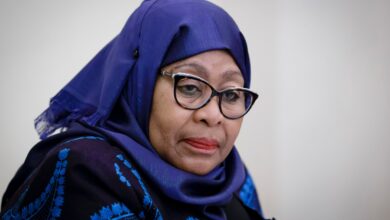
US Vice President Kamala Harris Hails Tanzanian President, Announces Trade Boost
The United States (US) Vice President Kamala Harris on Thursday announced an initiative to expand trade with Tanzania as she…
Read More » -
Equatorial Guinea
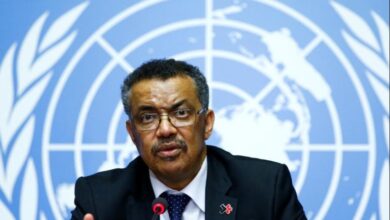
WHO Confirms Eight New Marburg Cases In Equatorial Guinea, Kills 20
The World Health Organization (WHO) on Thursday said eight new Marburg cases have been reported in Equatorial Guinea and the…
Read More » -
Tanzania

Tanzanian Health Ministry Confirms Country’s First Ever Marburg Virus Cases
The Tanzanian health ministry on Tuesday confirmed the country’s first-ever cases of Marburg Virus Disease after laboratory tests were carried…
Read More » -
Tanzania
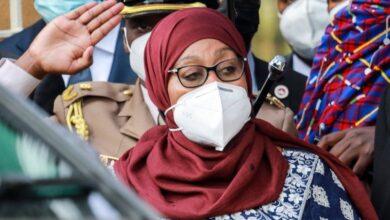
Tanzania’s President Samia Hassan Lifts Six Year Old Ban On Opposition Rallies
Tanzania’s President Samia Suluhu Hassan on Tuesday announced lifting of a six-year-old ban on opposition rallies imposed in 2016 by…
Read More » -
Tanzania

Tanzanian PM Kassim Majaliwa Says Death Toll From Sunday’s Plane Crash Rises To 19
Tanzanian Prime Minister Kassim Majaliwa said the death toll from Sunday’s plane crash in Lake Victoria has jumped to 19,…
Read More » -
Tanzania
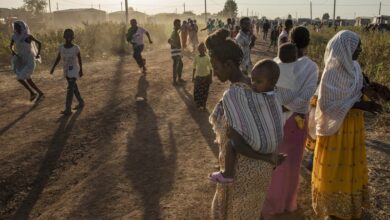
EACJ Rejects Maasai Community’s Petition Against Tanzanian Government
The East African Court of Justice (EACJ) on Friday rejected a petition by the Maasai community against the Tanzanian government…
Read More » -
Tanzania

Tanzania: Task Force Says Constitutional Reforms To Wait Until After 2025 Polls
Tanzania will start the process of drafting a new constitution after the general elections in 2025, said Prof Rwekaza Mukandara,…
Read More » -
Tanzania
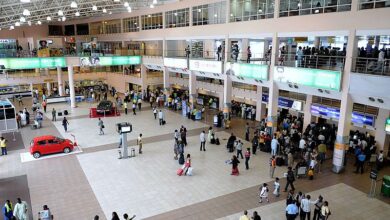
Tanzanian Government Releases Updated COVID-19 International Travel Advisory
The Tanzanian health authorities have updated the COVID-19 international travel advisory, allowing fully vaccinated travelers, including Tanzanians, returning residents, and…
Read More » -
Tanzania
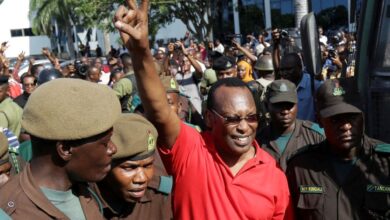
Tanzanian Court Orders Release Of Imminent Opposition Leader Freeman Mbowe
A Tanzanian court on Friday ordered the release of opposition leader, Freeman Mbowe, after prosecutors dropped terrorism charges against him,…
Read More » -
Tanzania
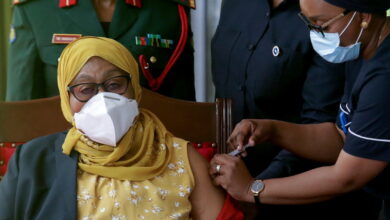
Tanzanian President Samia Suluhu Hassan Kicks Off COVID-19 Vaccination Campaign
Tanzanian President Samia Suluhu Hassan on Wednesday launched a COVID-19 vaccination campaign in the country, reported Africa News. The government…
Read More » -
Tanzania

Tanzanian Government To Begin COVID-19 Vaccination Campaign On Wednesday
Tanzanian Health Minister Dr. Dorothy Gwajima on Monday announced the government will begin the COVID-19 vaccination campaign on Wednesday, July…
Read More » -
Tanzania

Tanzanian Government Bans Unnecessary Gatherings To Curb COVID-19 Spread
The Tanzanian government on Thursday announced a ban on all unnecessary gatherings due to the ongoing COVID-19 pandemic, reported CGTN…
Read More » -
Tanzania

Tanzanian President Urges Citizens Not To Ignore Third Wave Of COVID-19
Tanzanian President Samia Suluhu Hassan on Friday urged the public not to ignore the third wave of COVID-19 and to…
Read More » -
Tanzania

Tanzanian President Samia Hassan Stresses Importance Of Wearing Face Masks
Tanzanian President Samia Suluhu Hassan on Friday stressed the importance of wearing face masks in fighting the COVID-19 pandemic, reported…
Read More » -
Tanzania

Tanzanian Government Announces New Anti-Coronavirus Measures To Curb New Variants
Tanzanian government on Monday announced a slew of new COVID-19 containment measures that are expected to prevent the importation of…
Read More » -
Tanzania

Tanzanian President Suluhu Vows To Defend Democracy, Basic Freedoms In The Country
Tanzanian President Samia Suluhu Hassan on Thursday vowed to defend democracy and basic freedoms in the East African country, reported…
Read More » -
Tanzania

Tanzanian President Hassan Says It’s Not Proper To Ignore COVID-19 Pandemic
Tanzanian President Samia Suluhu Hassan on Tuesday said it is not proper to ignore the COVID-19 pandemic, hinting at a…
Read More » -
Tanzania

Tanzania: Samia Suluhu Hassan Gets Sworn In As Country’s First Female President
Tanzania’s Vice President Samia Suluhu Hassan was sworn in as the country’s first female president on Friday after President John…
Read More » -
Tanzania
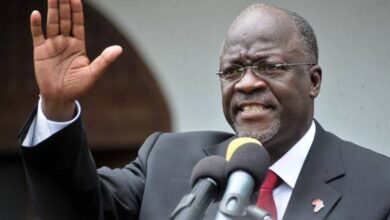
Tanzanian President John Magufuli Dies Of Cardiac Complications At Age Of 61
Tanzanian President John Magufuli has died of heart complications at the age of 61, the country’s Vice President Samia Suluhu…
Read More » -
Tanzania
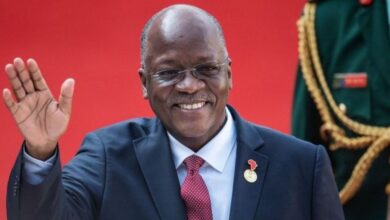
Tanzanian Vice President Gives Clues About President John Magufuli’s Health
Tanzanian Vice President Samia Suluhu Hassan has implied that President John Magufuli could be indisposed but urged people to refrain…
Read More » -
Tanzania
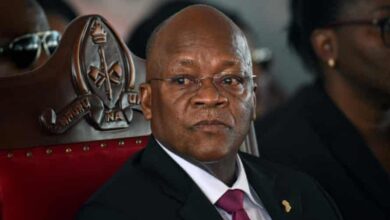
Tanzanian PM Says President John Magufuli Is Absolutely Fine & Working Hard
Tanzanian Prime Minister Kassim Majaliwa on Friday said President John Magufuli is in the country and working hard in his…
Read More » -
Tanzania
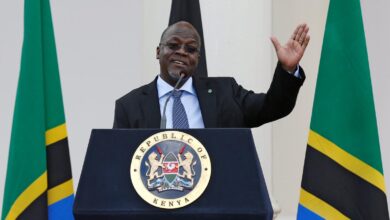
Tanzanian President Is In India Receiving COVID 19 Treatment, Says Opposition
Tanzanian main opposition leader Tundu Lissu on Thursday claimed President John Magufuli is currently in India receiving medical treatment for…
Read More »

